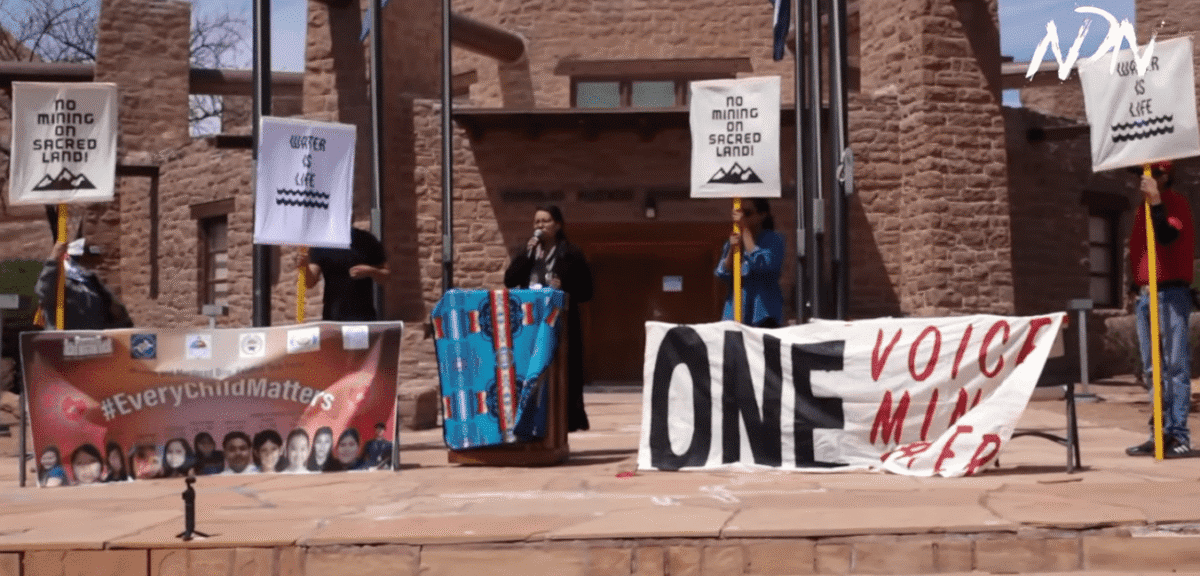By Hannah Grover
Navajo Nation advocates urged their leaders to stand against federal attempts to increase uranium extraction on Diné lands and the transport of uranium ore across the reservation.
The advocates spoke Monday as Tribal leaders gathered in Window Rock, Arizona, for the start of the spring Navajo Council session.
The coalition of advocates say they want more transparency and accountability from the Navajo Nation leaders, especially President Buu Nygren.
The speakers expressed concerns that tribal leaders could repeat the mistakes of the past that have left Navajo Nation lands scarred with abandoned uranium mines and oil and gas infrastructure. They also spoke out against a push to increase coal mining and power production even as plants on and around the reservation have closed in recent years or are scheduled to shut down.
They say Nygren and other Tribal leaders should stand up against future coal, oil and gas development on Navajo lands and should stop the transport of uranium ore across the reservation.
The protest comes after Nygren issued a statement of support for President Donald Trump’s executive order supporting coal development.
In his statement, Nygren noted that the Navajo Transitional Energy Company was the third largest producer of coal in the country in 2024.
“If the federal government is serious about increasing domestic energy production, enhancing permitting, and bolstering energy security, it must work in partnership with tribal nations,” Nygren said in his statement supporting Trump’s executive order. “Together, we can strengthen local economies, generate revenue, and create good-paying jobs in historically underinvested areas like ours.”
The sole remaining coal-fired power plant in New Mexico is located on Navajo Nation lands and is partially owned by NTEC.
During the protest, speakers altered between Diné bizaad — the Navajo language — and English as they called for action and accountability from their Tribal leaders.
“Our lands have been affected by oil and gas, coal, uranium mining, and there’s a lot of waste issues associated with all of that extraction that has happened on our land,” Robyn Jackson with the advocacy group Diné CARE said.
Jackson, who is a resident of Wheatfields, Arizona, spoke about the potential for future extractive industry and the impacts of climate change on the Nation.
She said there are proposals for increased oil and gas drilling, coal mining and “also some projects out there that haven’t really been tested elsewhere, but they want to test it on Navajo lands.”
Jackson gave the example of carbon sequestration and hydrogen pipelines.
The advocates say the Navajo Nation should not be used as a test site for emerging technologies, including the high-pressure slurry ablation that the U.S. Environmental Protection Agency has evaluated as a possible means to clean up abandoned uranium mine waste.
These proposals come even as residents of the Navajo Nation do not have access to water either for irrigation or drinking.
While many Navajo Nation residents may not have access to water, energy projects such as coal-fired power plants have drawn on water resources. The Four Corners Power Plant, which began operating in the mid-1960s, uses about 14.3 million gallons of water daily, which is drawn from the San Juan River, according to the advocates.
In other parts of the Navajo Nation, water resources have been contaminated by the uranium industry. While uranium mining ended on the Nation in 1986, a renewed interest in nuclear power has led to increased interest in uranium extraction. This comes even as existing abandoned uranium sites remain unremediated on the Navajo Nation.
Jackson spoke about the toll the uranium industry has had on the Navajo Nation.
“There isn’t one Diné family who hasn’t lost someone to something like cancer,” she said.
The advocates condemned the Nygren administration’s support for the failed state Senate Bill 316, which would have impacted efforts to move uranium mine waste from the Church Rock area to a landfill near Thoreau.
They further demanded that no new uranium mining occur on lands near the Mount Taylor Traditional Cultural Property area. Mount Taylor is a sacred site for several Indigenous tribes including the Navajo Nation.
Cheyenne Antonio — the energy organizer with Diné CARE who is from Pueblo Pintado, a community near Chaco Culture National Historical Park — spoke about the trauma that the extractive industries “have inflicted on our people.”
“We need to start shaming our leaders for selling us out,” Antonio said.

